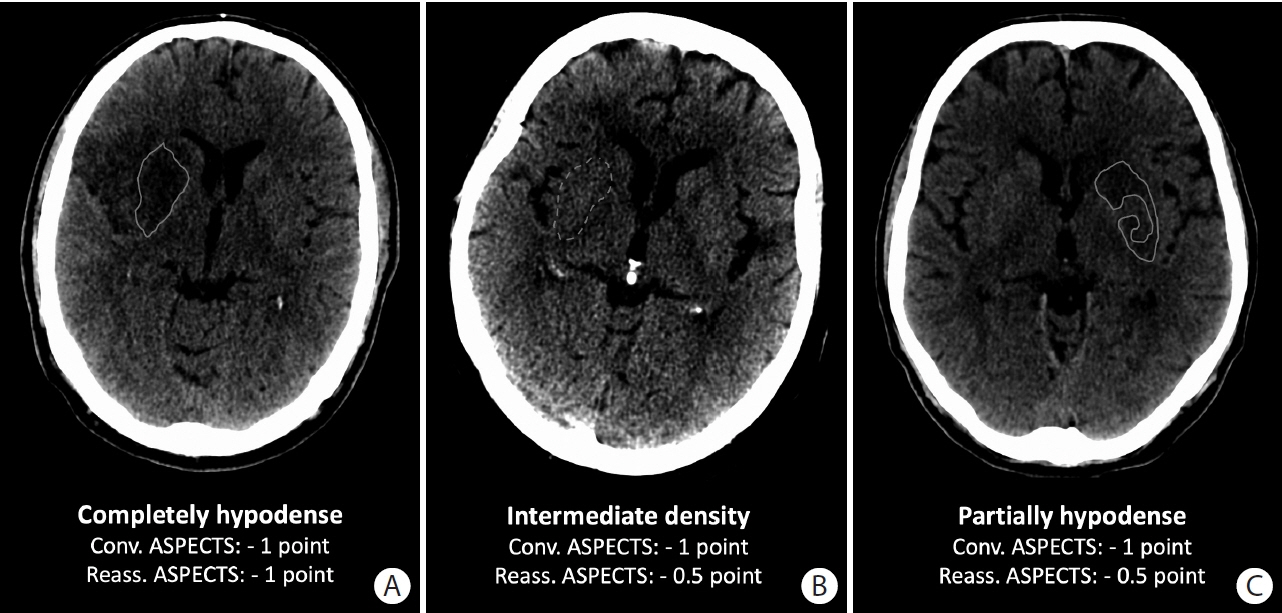J Stroke.
2021 Sep;23(3):440-442. 10.5853/jos.2021.00458.
Reassessing Alberta Stroke Program Early CT Score on Non-Contrast CT Based on Degree and Extent of Ischemia
- Affiliations
-
- 1Department of Clinical Neurosciences, University of Calgary, Calgary, AB, Canada
- 2Department of Neuroradiology, University Hospital of Basel, Basel, Switzerland
- 3Department of Diagnostic Imaging, University of Calgary, Calgary, AB, Canada
- 4Department of Neurology, Medical University of Vienna, Vienna, Austria
- 5Marcus Stroke & Neuroscience Center, Department of Neurology, Grady Memorial Hospital, Emory University School of Medicine, Atlanta, GA, USA
- 6Department of Diagnostic Imaging, Warren Alpert School of Medicine at Brown University, Providence, RI, USA
- 7Department of Neurology, Warren Alpert School of Medicine at Brown University, Providence, RI, USA
- 8Department of Neurosurgery, Warren Alpert School of Medicine at Brown University, Providence, RI, USA
- 9Centre Hospitalier de l’Université de Montréal, Montreal, QC, Canada
- 10University of Alberta Hospital, Edmonton, AB, Canada
- 11NoNo Inc., Toronto, ON, Canada
- KMID: 2520921
- DOI: http://doi.org/10.5853/jos.2021.00458
Figure
Reference
-
References
1. Logan C, Maingard J, Phan K, Motyer R, Barras C, Looby S, et al. Borderline Alberta Stroke Programme Early CT Score patients with acute ischemic stroke due to large vessel occlusion may find benefit with endovascular thrombectomy. World Neurosurg. 2018; 110:e653–e658.
Article2. Hill MD, Goyal M, Menon BK, Nogueira RG, McTaggart RA, Demchuk AM, et al. Efficacy and safety of nerinetide for the treatment of acute ischaemic stroke (ESCAPE-NA1): a multicentre, double-blind, randomised controlled trial. Lancet. 2020; 395:878–887.3. Aarts M, Liu Y, Liu L, Besshoh S, Arundine M, Gurd JW, et al. Treatment of ischemic brain damage by perturbing NMDA receptor- PSD-95 protein interactions. Science. 2002; 298:846–850.
Article4. Menon BK, d’Esterre CD, Qazi EM, Almekhlafi M, Hahn L, Demchuk AM, et al. Multiphase CT angiography: a new tool for the imaging triage of patients with acute ischemic stroke. Radiology. 2015; 275:510–520.
Article5. Saposnik G, Menon BK, Kashani N, Wilson AT, Yoshimura S, Campbell BCV, et al. Factors associated with the decisionmaking on endovascular thrombectomy for the management of acute ischemic stroke. Stroke. 2019; 50:2441–2447.
Article
- Full Text Links
- Actions
-
Cited
- CITED
-
- Close
- Share
- Similar articles
-
- Alberta Stroke Program Early CT Score in the Prognostication after Endovascular Treatment for Ischemic Stroke: A Meta-analysis
- The S100B Protein Could Be Used as Adjuvant Diagnostic Tool in Acute Ischemic Stroke
- Visibility of CT Early Ischemic Change Is Significantly Associated with Time from Stroke Onset to Baseline Scan beyond the First 3 Hours of Stroke Onset
- Endovascular Treatment in Acute Ischemic Stroke: A Nationwide Survey in Korea
- Penumbral Imaging-Based Thrombolysis with Tenecteplase Is Feasible up to 24 Hours after Symptom Onset



